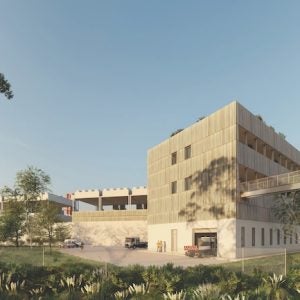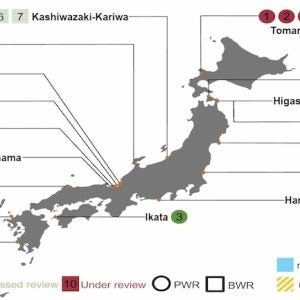The first of three Mitsubishi M701F single shaft combined cycle units at Entergy’s Saltend 1200 MWe merchant cogeneration plant in northern England was recently run-up very smoothly to full power within one month of first firing. First firing on the second unit was recorded during the run-up of the first unit, and first firing of the third unit is imminent. This in itself is a rare achievement in these days of advanced gas turbine technology. Commercial operation is scheduled for the middle of 2000.
Unusual flexibility and added reliability of the whole system has been achieved by a novel boiler arrangement and start-up routine engineered into an elegantly simple design concept provided by the turn-key suppliers Raytheon Engineers and Constructors and Mitsubishi. All this was provided for a lump-sum turn-key EPC contract of little over $400/kW.
Some 120 t/h of process steam and 100 MW of the electrical power are to be supplied to the adjacent BP Amoco chemicals complex on whose ground on the banks of the River Humber the generating plant is sited. The site is leased, however, from ABP (Associated British Ports) at a favourable rate. Cooling water does not come directly from the Humber estuary but is piped from within the Hull port complex which serves as a settling reservoir.
Quality management
The enterprising approach to asset management developed by Engica for Saltend was described just one year ago in the June 1999 issue of Modern Power Systems, pp 49 – 51. During 1999 the safety management system achieved the British Safety Council’s top 5 Star award with a 97.24 per cent rating. The top national safety award “sword of honour” was awarded to the project and the programme also received a National Safety Award from the BSC for its innovative approach as well as the RoSPA merit award for 1999.
The project originated as a 100 per cent BP Amoco enterprise back in 1996, but it was quickly put out to tender for a power company to take over and develop the site. BP Amoco retained the privilege to supply gas under a 15 year set price take-or-pay gas supply agreement (GSA), and also stipulated the conditions for supply of their process steam and electricity requirements. The rest of the output would be sold to the Electricity Pool of England and Wales on a merchant basis.
BP Amoco will supply some 1.8 million therms per day of natural gas from North Sea reserves to be delivered to the project via the NTS. The transport connection from the National Transmission System is very close, so pipeline costs were minimal. A gas reception terminal on the plant site provides for pressure reduction, gas preheating and metering.
Tenders for the project, which had the backing of a $1.2 billion loan from the Union Bank of Switzerland (UBS), were received from organisations all round the world. Of the six tenders in the final short list, two were indigenous UK offers and four were from offshore developers. The large US power company Entergy, based in New Orleans, was the successful bidder and SCCL (Saltend Cogeneration Company Ltd.) was formed to execute the project.
Entergy Corporation is an energy company supplying some 2.5 million customers in its US service area covering 112 000 square miles across Louisiana, Texas, Mississippi and Arkansas. The company owns more than 30 000 MWe of generation capacity around the world and employs about 12 000 personnel.
Entergy are developing another large combined cycle in the UK – the 800 MWe Damhead Creek plant in Kent – which is a 2 + 1 combined cycle system rather than a single shaft arrangement as at Saltend.
Financial arranging for a debt/equity ratio of 90 per cent was mainly committed to UBS of Switzerland. The leading agent bank was Warburg Dillon Read/UBS and the subordinated credit agent was The Toronto Dominion Bank. Co-arrangers included NationsBank, Toronto-Dominion Bank, Barclays Capital, and Dresdner Kleinwort Benson.
The capital structure of the £480 million total funding consisted of £360 million of senior debt (75 per cent), £72 million of subordinated debt (15 per cent) and £48 million equity (10 per cent).
Under a 15 year O&M agreement between SCCL and Entergy Power Operations UK, operation and maintenance costs and a fixed management fee are paid directly by SCCL with an incentive compensation bonus scheme or penalties for availability, heat rate, security of supply of power and steam to BP and other elements of performance.
A six year maintenance agreement between SCCL and Mitsubishi Corporation under the EPC agreement is quite remarkable. It covers all major maintenance for the power island for a fixed price paid in monthly instalments, guaranteeing 95 per cent availability of the combined cycle plant though the winter months and 91.25 per cent availability through the summer months. This commitment is apparently tied back to loss of profit based on predicted pool prices estimated in 1997.
The EPC agreement guarantees a net power output of 1 175 353 kW with steam supply to BP Amoco. Without steam export a net output of 1 206 000 kW is expected.
Kier Construction carried out the main civil construction, Ledwood handled the mechanical construction and Lightning performed the electrical construction.
Plant design
The plant is laid out on a compact, 25 acre, narrow site along the river bank. With the two rows of wooden frame hybrid forced draft cooling towers dominating the view.
The three MHI 701F gas turbine units are rated at 270 MWe apiece. The 701F has a 14 stage compressor, 20 low NOx combustor cans raising turbine inlet temperature to 1450°C and a four stage turbine. Exhaust gas temperature is in the region of 540°C. The gas outlet temperature from the 60 m high stack is around 80°C.
The heat recovery steam generators, designed by Austrian Energy, are three pressure level plus cold reheat, natural circulation, vertical flow of modular construction. Steam conditions are shown in the table above.
Mitsubishi supplied the two cylinder tandem compound double exhaust steam turbines. They have a combined HP/IP turbine cylinder and a separate LP cylinder arranged for downward exhaust to the underslung condenser. The condenser, also designed by MHI, is of the double pass water box type with 14 000 titanium tubes. Mechanical draught hybrid cooling towers by Marley Davenport are of low plume visibility counterflow design.
The single 400 MWe (465 MVA) hydrogen cooled generators on each shaft are supplied by Alstom. They generate at 24 kV, 50 Hz which is stepped up to 275 kV by the unit transformer. The National Grid Co provided the local substation, which required a 20km connection to the national network. This was achieved by replacing an existing 132 kV connection to the Saltend Works with a 275 kV line and also allowed the removal of a 132 kV connection into Hull which resulted in a net reduction of towers in the area.
An ABB CE (now Alstom) 150 t/h secondary boiler is included to provide backup for the process heat steam supply to BP Amoco, and a separate 60 t/h start-up boiler, also by ABB CE, is used to give the system its extraordinary operating flexibility and reliability.
There is no HRSG bypass stack and damper, neither does the plant have black start capability. But running up is not effected by using the generators as start-up motors, it is done by feeding steam from the start-up boiler to the steam turbine to run the shaft line up to 700 r/min, providing cooling steam for the last row LP rotor and sealing glands, and then bringing the speed down to around 550 r/min to initiate gas turbine firing.
This avoids all the expense and complexity of power electronics and control systems required for generator run-up, and since it is necessary to have some 4 MW of steam passing through the LP turbines at zero load, why not use this energy in running up the machine?
The special design of the HRSG, which uses natural circulation to avoid problems with water pumps on two shifting, used in combination with the start-up boiler steam run-up allows highly flexible load following and two shifting operation without incurring high maintenance overheads. The hot start up characteristics for two shifting operation are shown in the diagram below. The first machine had already recorded some 50 start-ups including two-shifting mode at the time of writing.
A relatively simple water treatment plant is required for this type of plant. The system supplied by Glegg includes three carbon filter units, three strong acid cation units, two forced draft decarbonisers, three anion units and three mixed bed units.
Prospects
Many IPP power plants in the UK are tied to long term set price, even back-to-back gas tolling or arbitrage gas contracts. In three or four years time, when, according to most oil and gas suppliers at least, natural gas prices are destined to double and continue to increase rapidly, these contracts could look very attractive.
Whatever happens, Saltend will have at least ten per cent of its predicted income more or less assured by the deal with BP Amoco. The operators confidently predict that they will be running very profitably on base load all year round, but even if they are reduced to two shifting or even peak shaving during the summer months, their fundamental economics seem to promise attractive return-on-investment prospects.






